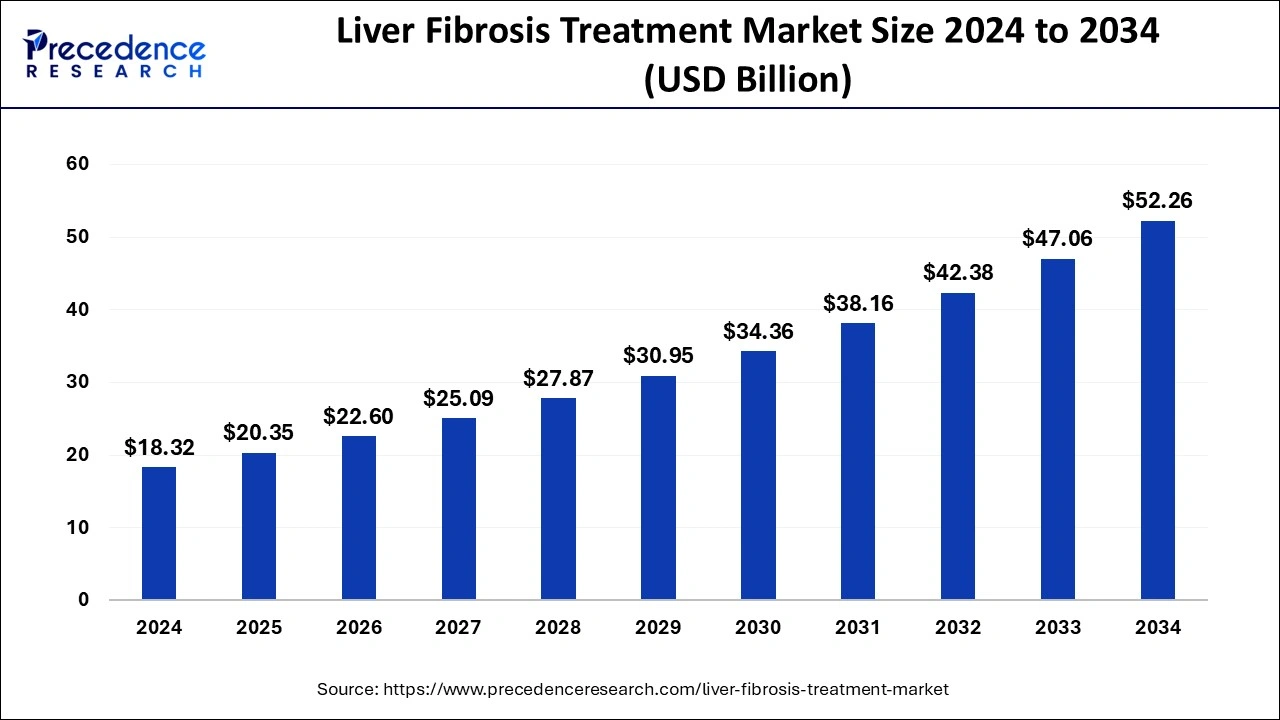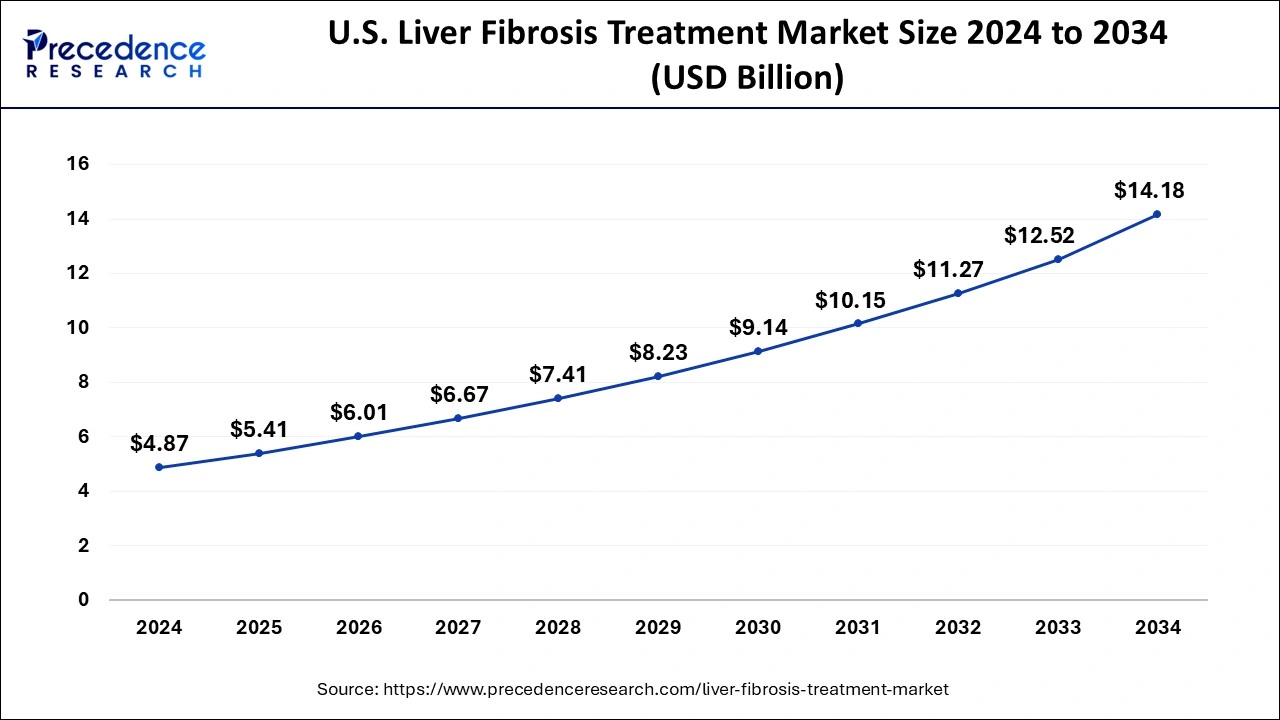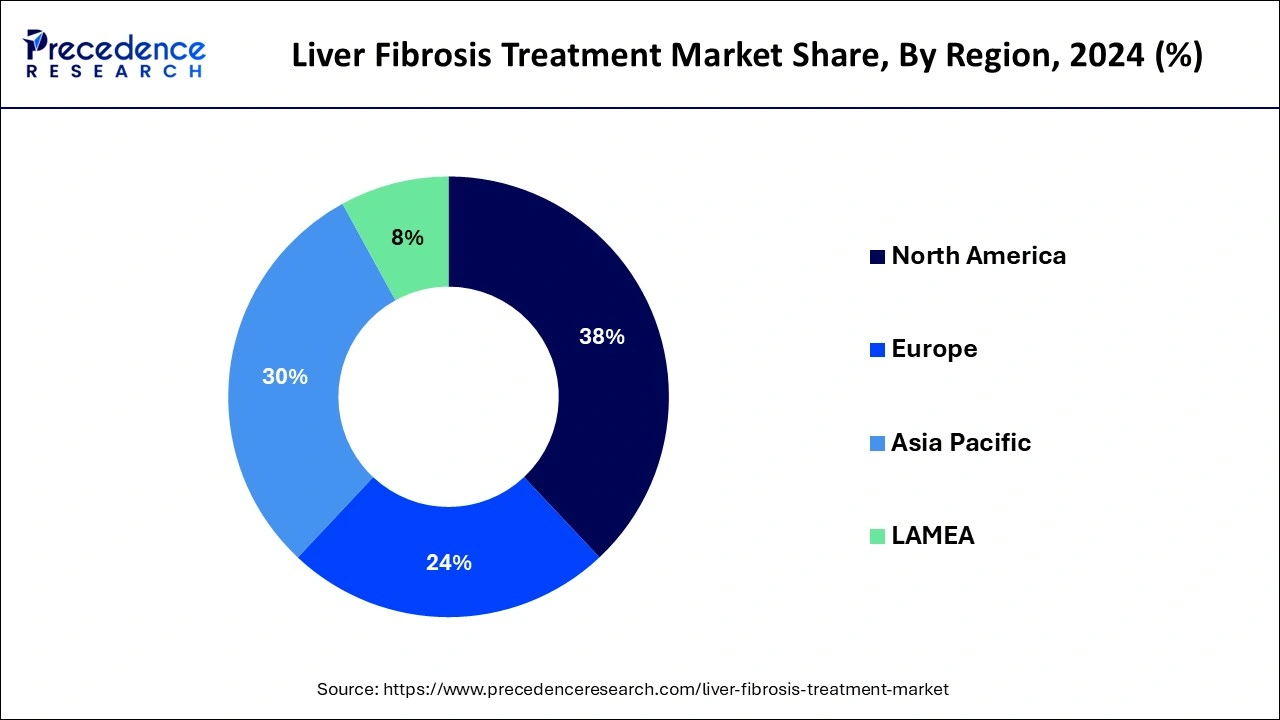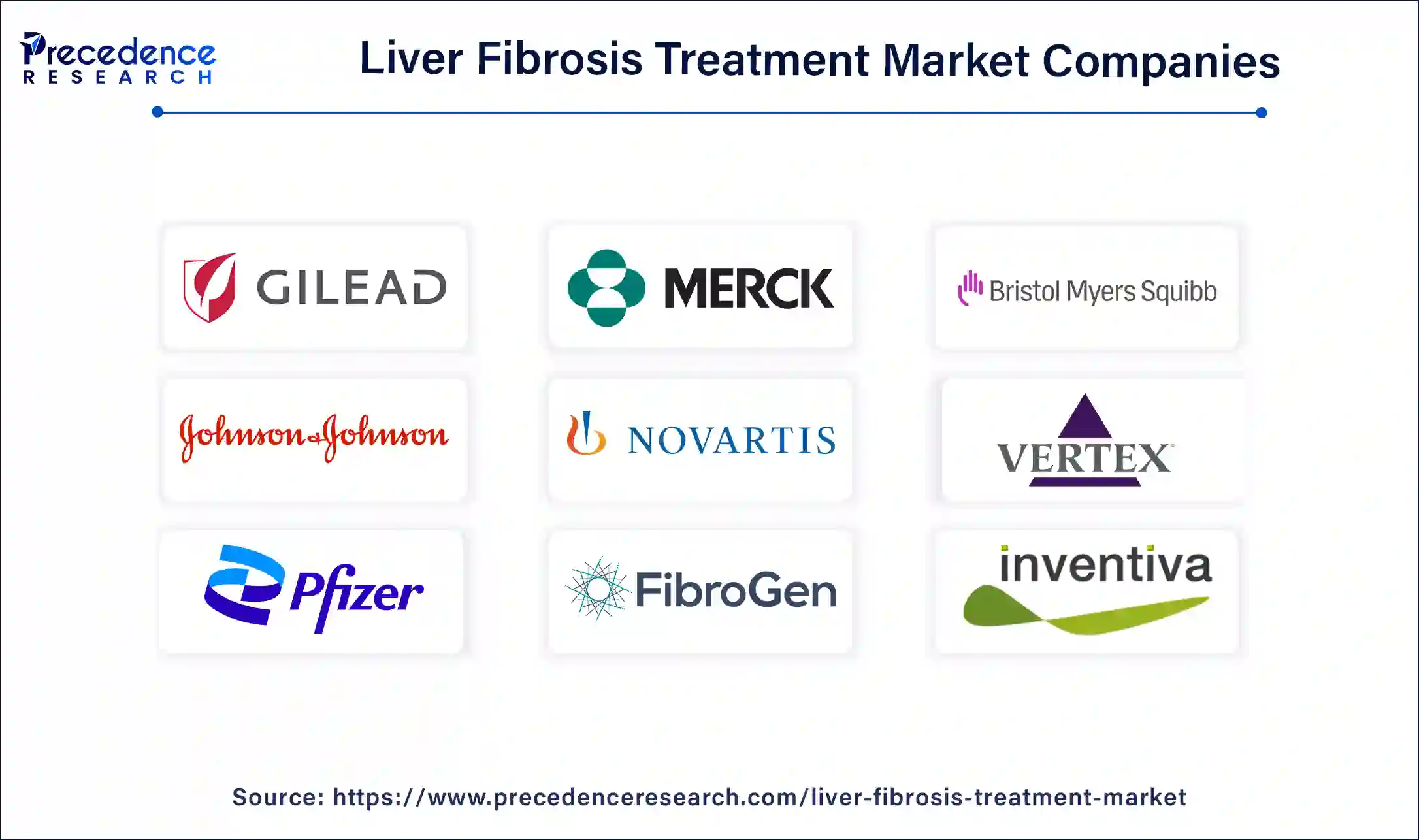January 2025
The global liver fibrosis treatment market size is accounted at USD 20.35 billion in 2025 and is forecasted to hit around USD 52.26 billion by 2034, representing a notable CAGR of 11.05% from 2025 to 2034. The North America market size was estimated at USD 6.96 billion in 2024 and is expanding at a CAGR of 11.19% during the forecast period. The market sizing and forecasts are revenue-based (USD Million/Billion), with 2024 as the base year.
The global liver fibrosis treatment market size accounted for USD 18.32 billion in 2024 and is expected to exceed USD 52.26 billion by 2034, growing at a CAGR of 11.05% from 2025 to 2034. The liver fibrosis treatment market is growing due to increasing disease incidence such as NAFLD, hepatitis, and cirrhosis. These include improved drug innovation and enhanced diagnosis.

Integration of artificial intelligence in the liver fibrosis treatment market includes prediction of the future distribution of liver diseases, search for cheaper diagnostic tools for early liver disease detection, understanding of the mechanisms of pathogenesis of liver fibrosis, cirrhosis, and hepatocellular carcinoma, and identification of how to treat infection about various liver diseases. Thus, the combination of AI models in NC-MRI can make accurate staging of liver fibrosis. This advancement can further improve diagnostic and therapeutic decision-making for patients with chronic liver conditions.
The U.S. liver fibrosis treatment market size was exhibited at USD 4.87 billion in 2024 and is projected to be worth around USD 14.18 billion by 2034, growing at a CAGR of 11.27% from 2025 to 2034.

North America accounted for the largest share of the liver fibrosis treatment market in 2024. With the increasing incidence of liver diseases, including NAFLD and hepatitis, there is a need for efficient diagnostic platforms. With the rise in liver diseases, patients are encouraged to seek professional care, and the number of patients is rising. The increased innovations in diagnostics methods, such as noninvasive imaging and biomarker tests, improve diagnosing and increase the survival of patients. The strong regulatory support and initiatives expected to improve liver disease awareness contribute to market growth. The major pharmaceutical and biotech companies in North America raise a competitive environment, driving research and development of new diagnostic solutions.

Asia Pacific is anticipated to witness the fastest growth in the liver fibrosis treatment market during the forecasted years. With the rising incidence rates of liver diseases, including hepatitis B & C and non-alcoholic fatty liver disease (NAFLD), the need for efficient diagnostic tests is on the rise. Liver-related diseases prevalent in countries like China, Japan, South Korea, and India have been proven to be on the increase due to rapid urbanization and lifestyle changes. There are several factors affecting liver treatment in the region, like the rising incidence of liver diseases and the deficiency of healthcare workers. Rising incidences are due to lifestyle changes, obesity, and urbanization.
Liver fibrosis leads to the deposition of extracellular matrix (ECM) components, predominantly collagen I and III, and fibrous septum that can impair the overall integrated hepatic performance. The main risk factors for liver fibrosis are alcohol consumption, chronic HCV infection, Non-alcoholic fatty liver disease, and NASH (steatosis not caused by alcohol use). Liver fibrosis is characterized by common molecular mechanisms, including hepatocyte death, chronic inflammation with disruption of the epithelial or endothelial barrier, cytokine release, and activation of HSCs.
The liver fibrosis treatment market is growing due to the rising incidence of injuries and inflammations in the liver that trigger excessive deposition of proteins like collagen and glycoproteins in between the hepatic cells. Besides, the increasing cases of risk factors like excessive consumption of alcoholism, obesity, autoimmune hepatitis, and destruction of bile ducts are further fueling the market growth. The advancements in next-generation plasma protein profiling, which help identify potential biomarkers of liver fibrosis and understand the disease mechanisms that can guide personalized treatment strategies, are also creating a positive outlook.
| Report Coverage | Details |
| Market Size by 2024 | USD 18.32 Billion |
| Market Size in 2025 | USD 20.35 Billion |
| Market Size in 2034 | USD 52.26 Billion |
| Market Growth Rate from 2025 to 2034 | CAGR of 11.05% |
| Dominating Region | North America |
| Fastest Growing Region | Asia Pacific |
| Base Year | 2024 |
| Forecast Period | 2025 to 2034 |
| Segments Covered | Treatment Type, Condition, End User, and Regions |
| Regions Covered | North America, Europe, Asia-Pacific, Latin America, and Middle East & Africa |
Increasing prevalence of liver fibrosis
Increased occurrence of various liver disorders, including autoimmune hepatitis, NAFLD, alcoholic liver disease, chronic hepatitis B and C, and liver fibrosis, is on the rise. These illnesses, when advanced, lead to liver fibrosis. Increased incidence of liver fibrosis all over the world is expected to boost the market. The rising incidence of risk factors like chronic Hepatitis B or C, HIV/AIDS co-infection, or taking immune-suppressing drugs post-liver transplantation is expected to boost the liver fibrosis treatment market. Moreover, the growth in the incidence of Liver Fibrosis around the globe has contributed to the market growth. Furthermore, increased spending on healthcare structures, ongoing advancements in the healthcare sector, and various government schemes have been launched to improve the health of people.
High cost of drug development
The product development of hepatotropic drugs is quite essential; the cost-bearing involved in these therapies is quite expensive, and this hampers the liver fibrosis treatment market growth. Every new pharmaceutical drug to the market undergoes preclinical research, clinical trials, and the approval process by regulatory and marketing of the product, which is time-consuming and costly. For pharmaceutical firms as well as biotech firms interested in investing in liver fibrosis research and development, the high cost of drug development and clinical trials remains a challenge.
Growth in research and development activities
The growth of the liver fibrosis treatment market is supported by rising research and development activity. The former will generate favorable opportunities for the expansion of the market. In addition to this, an increase in drug approval along with product launches. Also, higher investment in newer technologies and an increase in the number of emerging economies all add to the increased chances for the liver fibrosis treatment market growth in the forecast period. Opportunities include the rise of new professions and the rising tendency to invest in the development of new superior technologies.
The hepatotropic drug segment noted the largest share of the liver fibrosis treatment market in 2024. Hepatotropic drugs contribute to enhancing life quality, decreasing mortality rates in patients with liver fibrosis, and thus stimulating market growth. A hepatotropic drug is a drug that has a beneficial action on the liver, liver cell proliferation, and any process of liver detoxification. This growth is associated with the enhanced awareness of new drugs. Additionally, hepatitis is a sickness that mostly involves the liver and, subsequently, the digestive system and the brain in the worst three stages.
The hepatitis C segment has contributed the largest share of the liver fibrosis treatment market in 2024. Hepatitis C is a viral disease that is mainly targeted to the liver and, if left untreated, leads to acute as well as chronic liver disease. Other means of transmission are through the exchange of needles/syringes and other sharps or through receiving an unsafe blood transfusion or other unsafe medical procedures using unscreened blood products. There is a growing number of government activities to address the problem, and the enhanced understanding of the need to treat hepatitis C also contributes to the segment's growth. Hepatitis C patient demographics have reduced due to an increased awareness of the disease and also due to the effectiveness of the presently available drugs.
The hospitals segment dominated the global liver fibrosis treatment market in 2024. The majority of patients attend hospitals that incorporate diagnostic testing devices into their healthcare facilities. Therefore, the early detection and better diagnosis of diseases, as well as the availability of hospitals to deliver quality care to patients, are the factors currently driving the growth of the market. The increase in the incidence of hepatitis and other liver diseases across the globe has increased the utilization of hospitals for clinical diagnosis and, therefore, fueling the market. In addition, most of the mentioned hospitals possess highly developed imaging departments, including computed tomography (CT), Magnetic resonance imaging (MRI), and ultrasound, which are crucial for the diagnosis of liver diseases. Further, the hospitals offer invasive procedures like liver biopsies to get actual data on the state of the liver. This is because the majority of the patients depend on hospitals, which are mostly equipped with disease diagnostics. In addition, improvements in the existing framework of the healthcare sector also contributed to expanding the perspective of the segment.

By Treatment Type
By Condition
By End User
By Geography
For inquiries regarding discounts, bulk purchases, or customization requests, please contact us at sales@precedenceresearch.com
No cookie-cutter, only authentic analysis – take the 1st step to become a Precedence Research client
January 2025
May 2024
February 2025
September 2024